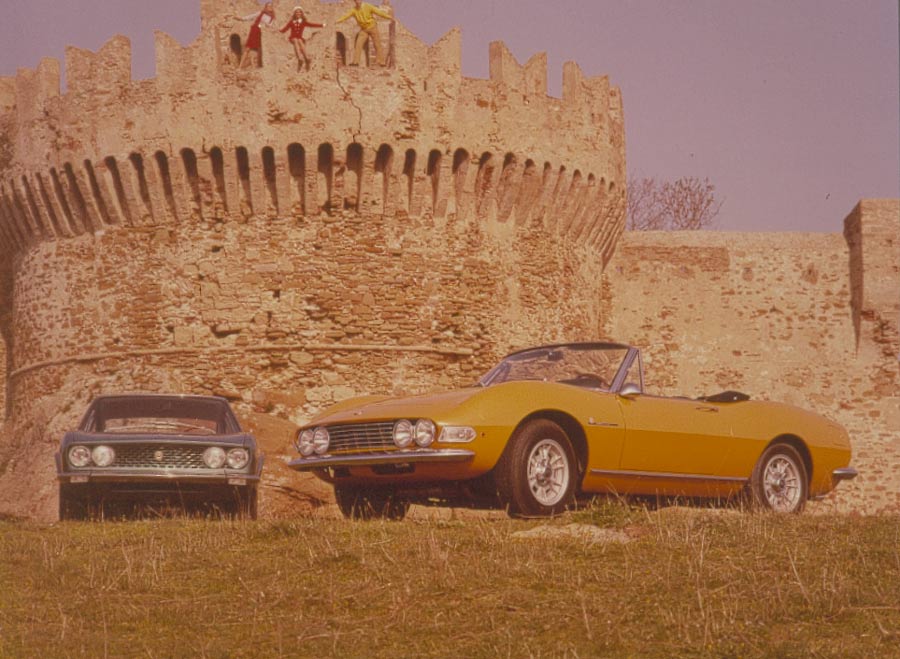A Ferrari engine is a special thing indeed. The Prancing Horse has built its reputation around powerful motors that deliver the performance you would expect from one of the world’s most storied and exclusive sports car brands.
However, while getting certain Ferraris onto your driveway may require a close relationship with your local dealership, years of documented enthusiasm, and enough in the bank to not only buy the car but also keep it in the manner to which it is accustomed, the engines themselves aren’t the exclusive parts.
There are a number of vehicles with Ferrari engines under the hood. Many of these oddities stem from Fiat’s relationship with Ferrari and the brand’s ownership of several other iconic Italian manufacturers. Many of the vehicles we’re about to mention are rare, though still less expensive than most Ferraris. However, others are surprisingly accessible. Here are five non-Ferraris that are powered by one of the Prancing Horse’s engines.
 Alfa Romeo Giulia Quadriofoglio
Alfa Romeo Giulia Quadriofoglio
When you think of the Ferrari’s F154 engine, you’ll probably picture a V8. This is the correct thing to do, as that’s how they came, with one notable exception. The 2.9 liter V6 used in the Alfa Romeo Giulia Quadriofoglio is the same F154 you’ll find in the likes of the Ferrari California — it just has a couple of cylinders missing. The Alfa Romeo does retain the flatplane crankshaft, which is an odd quirk in a V6. Despite dropping two cylinders over the V8 variant, the engine in the Giulia Quadriofoglio is still capable of churning out a very respectable 505 horsepower — making it one of the fastest sedans on the market.
The use of the engine follows Ferrari’s long-standing partnership with Fiat, which used to own Alfa Romeo directly. Both manufacturers and Lancia and Maserati are now part of Stellantis.
The Lancia Stratos HF
While some vehicles on this list are made far more interesting by the prancing horse under their hoods, the Lancia Stratos HF would still be remarkably interesting even if you ignored the legendary engine sitting just behind the driver’s seat. It’s one of those wedge-shaped sports cars from the mid-1970s, and it absolutely dominated the rally stages of its day—picking up three consecutive world titles between 1974 and 1976. It topped the podium in other racing events, too, including a win in the 1974 Targa Florio.
The Stratos HF almost missed out on a Ferrari engine, as Enzo Ferrari saw it as a potential competitor to his company’s Dino V6. However, when the production of the Dino V6 ended, that problem ended with it, and Ferrari agreed to deliver 500 engines to Lancia before ending the production of the six-cylinder motor. The combo led to one of the most interesting and successful Italian cars of all time, though fewer than 500 of the vehicles were produced before Lancia ended the Stratos HF’s run in 1978.
The Fiat Dino

In many ways, a Fiat is the opposite of a Ferrari. Although both manufacturers are Italian, Ferraris tend to be high-end, limited-run vehicles, while Fiats are affordable and built for the mass market. The difference in perception is so vast that legendary Barcelona striker Zlatan Ibrahimovic once described manager Pep Guadiola’s handling of him as akin to “Buying a Ferrari and driving it like a Fiat.
But underneath the hood of a certain Fiat, there are a lot of similarities. The Fiat Dino was born when Ferrari needed to swiftly produce 500 of the 2-liter V6 engines destined for the Ferrari Dino 166 Formula 2 racing car. Without that volume, the engine couldn’t be homologated, so the legendary sports car company struck a deal with Fiat, and the other Dino came out of it. The Fiat Dino was produced between 1966 and 1972, with later versions receiving a bigger 2.4 liter Ferrari engine.
The Maserati MC12
With a top speed of 205 MPH, the Maserati MC12 is the fastest road car the Trident has ever built. That speed is produced by the 12-cylinder, six-liter Ferrari engine sitting under the hood. The naturally aspirated engine is pretty much the same thing you’ll find in an Enzo, and performance wise the two vehicles aren’t a million miles apart.
Maserati only made 50 MC12s, but Ferrari engines didn’t just go into the rare supercar. They were pretty commonplace in the Italian sports car manufacturer’s performance models from 2002 until around 2020. Over the last few years, the Ferrari V8s that powered many a Maserati have been phased out in favor of the Trident’s own V6 Nettuno engines.
ASA 1000 GT “Ferrarina”
The ASA 1000 GT “Ferrarina” is a rarity in many ways. It was designed as an alternative to the full-sized and more expensive vehicles that Ferrari produced back in the 1950s. In an effort to keep costs down, it ended up packing something that Ferrari doesn’t really do in its road cars — a four-cylinder engine. That engine, along with the vehicle itself, was designed from the ground up by Ferrari engineers — so you aren’t just getting a Ferrari engine. You’re basically getting a smaller, more compact version of a Ferrari classic. In addition to the straight four in the 1000 GT, some ASA vehicles were also rocking an inline-six.
Unfortunately, ASA wasn’t long for this world. It began and died within a decade, only producing cars from 1961 to 1969. Examples of the ASA 1000 GT “Ferrarina” are pretty rare, and when you consider their history, it sounds like they may be very expensive. However, several examples have sold at auction in recent years for between $100,000 and just over $200,000. So it isn’t completely inaccessible. It’s Ferrari money, but lower-end, less-desirable Ferrari money. The ASA 1000 GT, still fulfilling its original purpose over 60 years on.

 Alfa Romeo Giulia Quadriofoglio
Alfa Romeo Giulia Quadriofoglio




